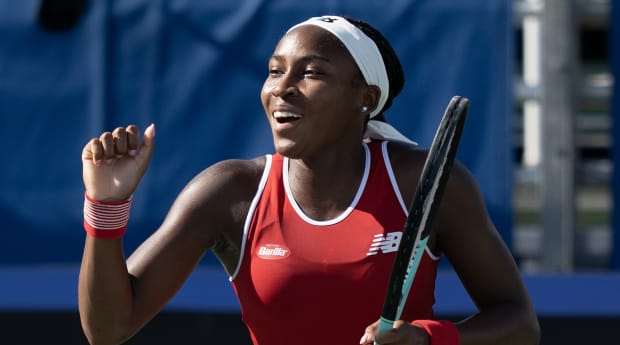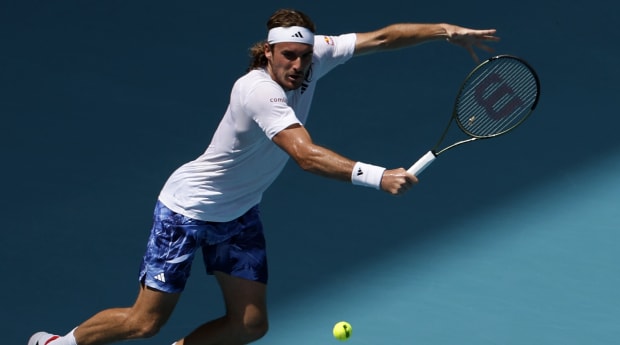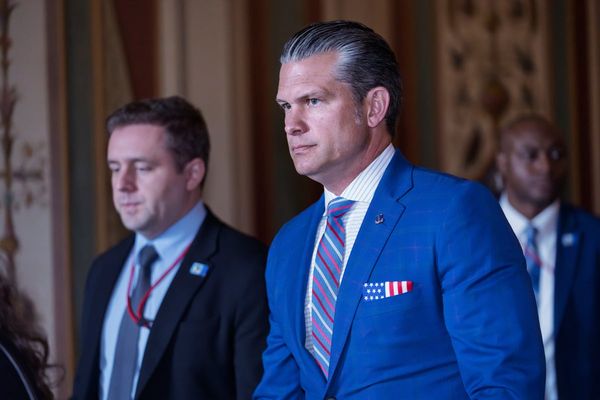While hearing that Jarmere Jenkins is Coco Gauff’s new co-coach ...
• Let’s start with the question from last week we promised to address.
On Hang Up and Listen last week, host Josh Levin stated boldly that U.S. men’s tennis was, improbably, in a better place than American women’s tennis. Josh makes a compelling point for why, for the first time in decades, you’d put your chips on the men. (Worth noting: He couched this much more as optimism for the men—who have three top-20 players—than as pessimism for the women. He also name-checked Katie Volynets.)
He put this question to me, and I took it to mean: what’s more likely, an American female major champ or an American male major champ? (It’s been—all together now—20 years since Andy Roddick won the 2003 U.S. Open. It’s been three-plus years since Sofia Kenin won in Australia.)

Susan Mullane/USA TODAY Sports
My position: I still have to go with the women. My logic, such as it is? Best-of-three versus best-of-five. It’s so much easier to win 14 sets in two weeks, versus 21. Statistically, it’s so much easier to pull an upset. It’s much easier for a blast of Raducanuian improbability. More sample size means greater opportunity for a regression to the mean. Can Taylor Fritz beat, say, Djokovic or Alcaraz or Medvedev, in best-of-three? Absolutely. Can he do it in best-of-five? Sure, but that’s a much different proposition.
Before nerding out too much on probability and sample size and the role of luck, let’s stop and acknowledge this peak market. After years of snickering and disappointment, the U.S. has such a cluster of top players. (The brightest prospect perhaps of them all, Seb Korda, has scarcely played in 2023 and is still a top-25 player.) It’s not just the sheer numbers, but the diversity. We’re so far from the serve-and-a-forehand-on-hard courts model. Frances Tiafoe plays nothing like Reilly Opelka. Most are 25 or younger.
The U.S. women are down from their highs. Serena Williams is retired. Some players are either slumping (Amanda Anisimova 3–7 this year) or injured (Jenn Brady) or in their sunset years. But if players were stocks, Coco Gauff would fetch the highest share price among the Americans. She reached a major singles final within the past 12 months, and she is still only 19. And she has to play only best-of-three.
Jon, I wrote to you a few months about this and what I surmised is seemingly coming true—Rafa is done. He pulls out of one tournament after another, the end game uncertain. Oh, if only he had retired on court last year at Roland Garros, trophy in hand. (And I said that at the time as well, believing it was never going to get better than that.) He should retire on court with trophy in hand, but alas, aka Roger, fate seems to have other plans. So, my question is, what do you think at this point Rafa's end game is?
Thank you,
Dominic Ciafardini, N.Y.
• This decision of when and whether to retire is brutal. And it belongs to the athlete themselves. This seems sort of ghoulish, but retirement is part of sports and respectful discussion/speculation seems to me within the bounds of being a fan. So let’s game this out.
If Nadal retires after the 2022 Roland Garros, trophy in hand, sure in retrospect it’s a glorious mike drop, the epitome of the cliché “go out on top.” It’s also nuts. He had just won the damn tournament! He had won the first two legs of the Grand Slam (for the first time in his career). Even at suboptimal health, he was racking up victories. Djokovic was a question mark. Zverev was out. Thiem was in decline. Wimbledon was an event he’d won multiple times and rediscovered after a mid-career drought. How do you retire under those terms?
Now we’re in 2023. Nadal is clearly physically compromised and has been—albeit with different injuries for 10 months—a shadow of his old self. He’s almost 37. For all his physical setbacks, he is still the defending champ in Paris. And this is an event he’s won 14 times, where his statue already decorates the grounds. Does he really not give it one last hurrah? It would be (technical term) such a bummer if he did not. And pragmatically, does he really deprive RG of his presence? If he announces à la Serena that this is his last event, will it freight him with extra pressure and take too much attention away from other players? If he waits and announces it between the French and Wimbledon, does he shortchange himself? (Why didn’t he do it in Paris when he could have gotten the grand send-off he deserves?) And what if he isn’t ready to retire at all and this is simply another injury he will eventually overcome, a hallmark of his career, a drill he’s undertaken since ’04 or so?
All of which is to say … this is a brutal decision. It’s a complicated decision. It’s his decision alone. And still, it’s like timing the stock market, seldom done perfectly.
One unexpected surprise from the recent Monte Carlo tournament was the match commentary from Chris Eubanks on Tennis Channel. I happened to (randomly) attend one of his qualifying matches at last year’s U.S. Open, so I was vaguely aware of him while watching his deep run in Miami a few weeks ago. In the announcing booth in Monte Carlo, every word out of Chris’s mouth was fresh and interesting, both about the situational play and about the strengths and weaknesses of the players. For someone who has only been in the top 100 for maybe a month, he seemed extraordinarily knowledgeable about the top players, many of whom—I would guess—he has never played. I don’t know if he’s the exception, or whether most players ranked outside of the top 80 are such students of the main tour. But it was fascinating to hear the perspective of such a thoughtful guy.
Rich, New York City
• Amen. A total revelation. I’ve done a few shows with Chris and he’s not just knowledgeable about tennis but is a TV natural. Confidence without pretension. Energy and optimism without being goofily over-the-top. Presence without look-at-me. And he works at it. Even while his playing career is in ascent.
Pet theory: The “curse of expertise” is very much at play with tennis (sports?) broadcasting. This is a cognitive bias that basically says “the better you are at something and the more naturally it comes, the harder time you have communicating.” You simply can’t relate to people not sharing your conversance and ease with the subject matter. There’s all sorts of social science here. Stanford engineers who can’t explain basic principles. Music virtuosi who struggle to teach kids. Ted Williams was supposedly one of the worst managers in baseball history. In tennis, the naturals aren’t always the best commentators and communicators. The sport often came easily to them. They didn’t need to grind and scout and really study mechanics. Some champions make great commentators. (See: Lindsay Davenport and Jim Courier. And Agassi’s stint in the ESPN booth several years was memorable.) But some of the best commentators are also players like Eubanks—or Robbie Koenig or Sam Smith—who were not necessarily natural talents but had to become students of the game.
The Boris Becker documentary on Apple TV+ was great and had all of the entertaining elements that Break Point on Netflix lacked. It had players and legends with charisma and real insight, funny anecdotes, matches with historical significance, packed arenas and stadiums, and serious off-court intrigue. Drive to Survive and Full Swing on Netflix get it right because they highlight the superstars of F1 and golf, and their glamorous lives. To grow the sport and add fans, there should be more shows like the Becker documentary. Someone (like you!) should do a multi-episode show on Agassi and Sampras, focusing on their lives and development from childhood, through their intertwining pro careers and rivalry, personal life drama, celebrity status, and up through the present day. I’m sure most legends in the sport would agree to be interviewed for that, including the Big Three, who were inspired by them. That would be a great show!
Dave H.
• I’m of mixed minds here. Tennis needs to anchor itself in the present, not the past. Every time I hear John McEnroe (whom I like overall) make these self-referential jokes about the 1980 and ’81 Wimbledon finals, and “pits of the world” and the heartbreak of the ’84 French Open, I want to say, “Dude, YOU cannot be serious. That was 40 years ago. Michael Jordan had yet to play in the NBA when you lost to Lendl. Two-thirds of the planet was not born. Imagine watching the NBA and hearing the broadcaster rehashing his exploits playing Dr. J in the early Reagan years.”
But these historical docs often work precisely because of the time elapsed. Apart from the intoxicant that is nostalgia, the thickener that is time enables the subjects to speak freely. Michael Stich can talk about Becker without having to run into him in the locker room the next week. Krickstein can talk about Connors without worrying about social media backlash or an agent advising him to sidestep controversy.
I like your idea. But what do you do about Sampras, who, as is his right, strenuously, avoids these kinds of opportunities and public appearances?
Promise to keep it between us, but here’s my tennis doc idea. Who wouldn’t watch 100 minutes on the 1998–2002 glory years of the WTA? At the dawn of the internet, at this inflection point for women’s sports overall (the WNBA has just launched, the U.S. wins the memorable 1999 World Cup, the Title IX tree is bearing fruit) here comes women’s tennis, leading the way. The Williams sisters are for real, fulfilling Richard’s pronouncements; Martina Hingis is the foil; Anna Kournikova is this global icon raising the age-old question whether selling sports is empowerment or exploitation; Jennifer Capriati (and Mary Pierce) will write a redemption story; Steffi Graf tiptoes away, never to return, and Monica Seles carries on with dignity, though the window has closed. A lot of characters and stories but also a larger tableau about the growth spurt for women’s sports; and this intersection between sports and commerce and the Williams sisters forcing us to reassess pathways and methods for success.
Hi Jon; Pickleball is not my friend, in fact it’s my mortal enemy. Golf, baseball, football, etc. are my friends, because they don’t encroach on my turf. At a local town tennis park there used to be four tennis courts, now there are two pickleball courts, one tennis court with pickleball lines that give me a migraine and one tennis court. I rest my case.
Best Regards,
Eric Bukzin, Manorville, N.Y.
• Devil’s advocacy: Your tennis skills will not translate instantly to the aforementioned sports.
The tennis/pickleball dynamic is real. And both sports would do well to figure out a strategy here. A few weeks ago, someone likened it to football versus cornhole. When four of the best NFL players of the past quarter century play cornhole while an NFL playoff game is in session (Agassi, McEnroe, Roddick and Chang event the day of the Miami final) … when cornhole begins taking over the physical space of football fields … when NFL players begin investing in cornhole teams … that analogy will be valid.

Geoff Burke/USA TODAY Sports
At 9–17, Tsitsi is on pace to be historically bad in finals.
James, PDX
• This was sent after Carlos Alcaraz overwhelmed Stefanos Tsitsipas to win the Barcelona final. Barely a year ago, Felix Auger Aliassime was not only 0–8 in finals, but had never won a set. Now he is 4–8. But to your point, Tsitsipas ought to be batting higher than .346. The problem with these statistics: Not only is the player keenly aware, but so is the opponent.
Hey Jon. Has anyone written a book about Dr. Renée Richards? Wasn’t she a transgender woman allowed to compete on the women’s tour?
@menforudders
• Renée Richards, American treasure, has written multiple memoirs and books. She was indeed allowed to compete on the women’s tour. This came after a lengthy legal battle and the battle lines (and logical fallacies) were much as they are today. She won some matches and lost others. But she was in her 40s. In her view, had she been able to play on the WTA Tour when in her athletic prime, she would have dominated and it would have been unfair. Her views on trans athletes are not, perhaps, what you would expect. I wrote this about Renée a few years ago when Martina Navratilova—whom Richards once coached—first found herself in the crosshairs of the trans community.
Jon, what did you make of the news that Roland Garros is moving up the time of the night session to 8:00? Will this make a difference? It didn’t seem like that experiment went over well last year.
Tommy, Boise, Idaho
• Yes, once again there are night sessions at Roland Garros. But this time they begin at 8 p.m. with an “interactive show” followed by a match. As to what constitutes a prematch “interactive show”—a flash mob, the Macarena, an Édith Piaf sing-along—one can only guess.
Anyway, especially two years after COVID-19, you can’t really begrudge a major a right to fish all of its revenue streams and add sessions. But this is really problematic for a variety of reasons.
1) It’s easy to forget how far north we are here. In June, the sun doesn’t set until nearly 10:00 p.m., which means that the day session won’t empty when the night session starts.
2) The Roland Garros venue, charming as it is, is the smallest of the majors by far, and isn’t built for turning around sessions swiftly.
3) There is time for only one night match. The fear is that if there’s a women’s match you might have a 6–1, 6–1, 52-minute stinker and the fans will feel cheated. So the men usually get the call. (The women were upset at first. Then they saw how weird and ambience-absent these sessions were. They saw how the winner’s circadian rhythms were thrown off. And they were like, “Nah, we’re good.”)
4) Paris’s public transportation is generally excellent. But it’s not 24 hours. Last year there was a late match, and fans were stranded, forced to hunt for cabs and find surge-priced (gouged) Ubers. To your question, I’m not sure moving this session up half an hour solves much.







